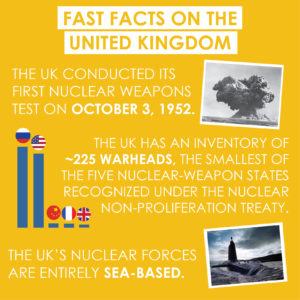 The United Kingdom began pursuing an atomic weapon in 1941 before merging with the United States’ own secret nuclear weapons program in 1943 — the Manhattan Project. It was two physicists working in the United Kingdom that first calculated the feasibility of constructing an atomic bomb that spurred the British government to action. The US-UK collaboration during World War II would come to an abrupt halt when the U.S. Congress passed the Atomic Energy Act of 1946. This act ensured that sensitive nuclear technology would not be shared between the two countries, so the United Kingdom decided to pursue a national nuclear weapons program in 1947.
The United Kingdom began pursuing an atomic weapon in 1941 before merging with the United States’ own secret nuclear weapons program in 1943 — the Manhattan Project. It was two physicists working in the United Kingdom that first calculated the feasibility of constructing an atomic bomb that spurred the British government to action. The US-UK collaboration during World War II would come to an abrupt halt when the U.S. Congress passed the Atomic Energy Act of 1946. This act ensured that sensitive nuclear technology would not be shared between the two countries, so the United Kingdom decided to pursue a national nuclear weapons program in 1947.
Construction of the United Kingdom’s first plutonium production reactors began in 1947 and it conducted its first nuclear explosive test on October 3, 1952. Known as Operation Hurricane, a 25-kiloton plutonium implosion bomb was detonated inside the hull of a frigate off the coast of an Australian island to simulate a nuclear weapon smuggled into a British harbor. The third nuclear-armed state after the United States and the Soviet Union, the United Kingdom produced its first nuclear weapon for its stockpile in 1953. It was not until the Mutual Defense Agreement of 1958 — after the United Kingdom tested a thermonuclear weapon — that collaboration resumed with the United States.
It is believed that the United Kingdom produced nine different types of warheads over the course of its nuclear history. Its stockpile peaked at approximately 500 warheads between 1974-1981 but has now dropped to about 225 warheads, about 120 of which are operationally available. However, in early 2021 the UK government reversed a 2015 pledge to reduce the overall nuclear stockpile to 180 by the mid-2020s. The landmark Integrated Review of Security, Defense, Development and Foreign Policy instead raised the cap to 260 warheads, a 40% increase and the first since the Cold War.
In 1998, the United Kingdom retired its last air-delivered nuclear weapon, the WE-177, so its nuclear forces are now entirely sea-based. The United Kingdom relies on its four nuclear-powered Vanguard-class submarines to maintain a continuous at-sea deterrent and a secure second-strike capability. The Vanguard is outfitted with Trident II submarine-launched ballistic missiles, which are purchased directly from the United States. The United Kingdom never developed its own ground-based missile for a nuclear triad, although the United States deployed Thor intermediate-range ballistic missiles to the United Kingdom in the early 1960s. However, these missiles were phased-out by 1964.
While maintaining the smallest deployed nuclear arsenal of the five nuclear-weapon states recognized under the Nuclear Non-Proliferation Treaty, the United Kingdom is deliberately ambiguous about “when, how and at what scale” it would choose to use its nuclear weapons, as well as its true operational stockpile.
Recent Analysis on the United Kingdom
- Gatekeeping nuclear-powered submarines: What will the precedent be? May 9, 2023
- How safe is depleted uranium and why is the UK’s decision to send it to Ukraine prompting debate? May 4, 2023
- On Royal Succession and Command and Control September 14, 2022
- The Next Generation of Arms Control April 14, 2022
- NATO 2030: What the new Strategic Concept should say about nuclear weapons September 30, 2021
- Fact Sheet: U.S. Nuclear Weapons in Europe August 18, 2021
- Fact Sheet: The United Kingdom’s Nuclear Inventory April 22, 2020
- Trump team was right to extend Iran deal waivers February 6, 2020
- Four Nuclear Submarines and a Tory Majority: Why renewed calls for Scottish independence could spell trouble for the UK’s nuclear weapons February 3, 2020
- A quick guide to the JCPOA Dispute Resolution Mechanism January 22, 2020

